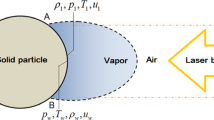Abstract
We present measurements of the electron concentration in wakes behind aluminum spherical models flying in air with velocity 3.4–5.7 km/sec at a pressure of 10–80 torr. We have calculated the heating and entrainment of aluminum from the surface of the models as they move within the flight range. We show that condensation of Al vapor may occur at distances of more than 100 diameters of the body and pressure ≳80 torr. We pose and solve the inverse problem of determining (from experimental data) the effective attachment coefficient for attachment to air molecules and the attachment rate constants for AlO+e→AlO−, AlO2+e→AlO2 −.
Similar content being viewed by others
References
E. P. Andreev, N. N. Pilyugin, O. K. Taganov, and S. G. Tikhomirov, Investigation of Emission of Gases in an Aeroballistic Experiment [in Russian], Izdat. Mosk. Univ., Moscow (1988).
N. N. Baulin, E. V. Ermakova, and N. N. Pilyugin, “Determination of the physicochemical constants in the flow behind a body from ballistic experiments,” Teplofiz. Vysok. Temp.,30, No. 2, 299–310 (1992).
A. N. Pilyugin and N. N. Pilyugin, “Determination of the physicochemical constants in the wake behind a body flying in nitrogen from ballistic experiments,” Astron. Vestn.,27, No. 5, 112–122 (1993).
A. N. Pilyugin, N. N. Pilyugin, and S. G. Tikhomirov, “Determination of the recombination constants for recombination of electrons with ions from ballistic experiments,” Teplofiz. Vysok. Temp.,31, No. 4, 517–525 (1993).
S. Yu. Menzhinskii and N. N. Pilyugin, “Determination of the physicochemical constants in the wake behind a body flying in argon with hypersonic velocity,” Teplofiz. Vysok. Temp.,31, No. 5, 787–794 (1993).
N. N. Pilyugin, S. G. Tikhomirov, and S. Yu. Chernyavskii, “Approximation method for calculation of the parameters of the air and radiant intensity in a far wake,” Izv. Akad. Nauk SSSR, Mekh. Zhidk. Gaza, No. 6, 165–175 (1980).
V. M. Kornegei, “Fall-off of electron density in wakes,” Raket. Tekh. Kosmon. [Russian translation of AIAA J.],3, No. 10, 37–42 (1965).
R. E. Slattery, W. G. Clay, and W. C. Wortington, “Range contamination and its effect on measurements,” Proceedings of the Second Congress on Instrum. in Aerospace Simulation Facilities, ICIASF'66, Record (1966), pp. 1–15.
H. Mach, “Spectroscopic studies in the wake of ablating models of hypersonic missiles” Raumfahrtforschung18, No. 1, 1–9 (1974).
N. N. Baulin, A. K. Dmitriev, N. N. Ivanchinov-Marinskii, et al. “Investigation of the flow behind a sphere for hypersonic flight velocity in air with an open microwave resonator,” Izv. Akad. Nauk SSSR, Mekh. Zhidk. Gaza, No. 4, 156–160 (1978).
V. B. Brodskii, S. E. Zagik, V. A. Lyutomskii, and G. I. Mishin, “Effect of the effective attachment coefficient for free electrons in ionized air of a hypersonic wake on a ballistic range,” Zh. Tekh. Fiz.,48, No. 5, 964–966 (1978).
L. P. Yarin and G. S. Sukhov, Principles of the Theory of Combustion of Two-Phase Media [in Russian], Énergoatomizdat, Leningrad (1987).
É. Z. Apshtein, N. N. Pilyugin, and G. A. Tirskii, “Investigation of disintegration of meteorite particles moving in the upper layers of the atmosphere,” Kosmich. Issled.,17, No. 6, 866–874 (1979).
J. L. Griffin and P. M. Sherman, “Computer analysis of condensation in highly expanded flows,” Raket. Tekh. Kosmon. [Russian translation of AIAA J.],3, No. 10, 29–36 (1965).
Ya. B. Zel'dovich and Yu. P. Raizer, Physics of Shock Waves and High-Temperature Hydrodynamic Phenomena [in Russian], Nauka, Moscow (1966).
D. I. Zhukhovitskii, A. g. Khrapak, and I. T. Yakubov, “Ionization equilibrium in a plasma with a disperse condensed phase,” in: Plasma Chemistry: Collected Papers (B. M. Smirnov, ed.) [in Russian], No. 11, 130–137 (1984).
N. N. Pilyugin, S. G. Tikhomirov, and S. Yu. Chernyavskii “Chemical kinetics in the far wake behind a body moving in air with hypersonic velocity,” in: Hypersonic Flows for Flow past Bodies and in Wakes [in Russian], Izdat. Mosk. Univ., Moscow (1983), pp. 5–19.
V. A. Kolemaev, O. V. Staroverov, and V. B. Turundaevskii, Probability Theory and Mathematical Statistics [in Russian], Vyssh. Shk., Moscow (1991).
A. E. Bezmenov and V. A. Aleksashenko, Radiophysical and Gasdynamic Problems of Passage through the Atmosphere [in Russian], Mashinostroenie, Moscow (1982).
N. N. Pilyugin, S. Yu. Menzhinskii, and A. N. Pilyugin, “Determination of the ternary recombination constant for recombination of electrons with aluminum ions from ballistic experiments,” Teplofiz. Vysok. Temp.,32, No. 5, 656–665 (1994).
Additional information
Scientific-Research Institute of Mechanics, Moscow State University, Moscow 119899. Translated from Fizika Goreniya i Vzryva, Vol. 31, No. 5, pp. 70–82, September–October, 1995.
Rights and permissions
About this article
Cite this article
Pilyugin, A.N., Pilyugin, N.N. Determination of recombination and attachment rate constants from ballistic experiments. Combust Explos Shock Waves 31, 566–576 (1995). https://doi.org/10.1007/BF00743808
Received:
Issue Date:
DOI: https://doi.org/10.1007/BF00743808




